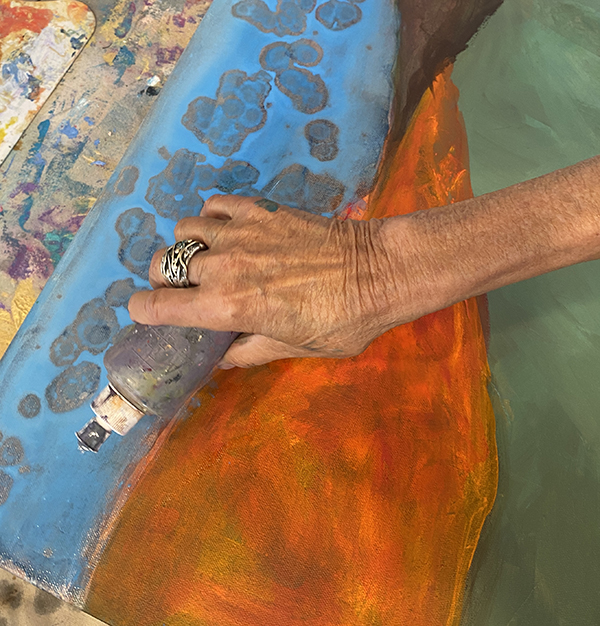How to Adopt a Playful Painting Process
Almost all creativity involves purposeful play.
Abraham Maslow
One of the best ways to create unique, dynamic abstract paintings is to stay focused on play in your practice. Abstract painting can feel challenging and intense, but incorporating playfulness can lead to new creative breakthroughs and a more enjoyable art-making experience. By letting go of expectations and embracing experimentation, you can discover new techniques and approaches to your work. In this article, we’ll explore the importance of being playful in abstract painting and how it can benefit your artistic practice.
Embrace Experimentation and Let Go of Expectations
One of the key ways to incorporate playfulness into your abstract painting practice is to let go of expectations and embrace experimentation. Instead of trying to create a specific outcome or replicate a certain technique, allow yourself to explore and play with different materials, tools, colors, and textures. Give up control about what the piece “should” look like, and instead, adopt a mindset that you are excited to see what emerges when you play.
When you let go of expectations, then you won’t be let down by what results from your playful process. I recommend that my students adopt the mantra, “What will happen if…”, and then do it! You won’t always love what happens when you play, but you will have fun and eventually discover a new technique or way of working that will inform your process.
With that said, paint is expensive. You might go to Michael’s and buy some of the less expensive paint to free you up to experiment more, and perhaps paint on watercolor paper or cheap canvases. When I am in painting play mode, I use Michaels’ Artists Loft Soft Body Paint. If I figure out a technique I love, then I will try it out with my professional paints.
Play is the highest form of research.
Albert Einstein
Incorporate Unconventional Materials and Techniques
Another way to infuse playfulness into your abstract painting practice is to experiment with unconventional materials and techniques. For example, you might put down the brush and paint with your fingers (wear protective gloves), a palette knife, or a brayer. You might also experiment with using found objects, like leaves or twigs, as tools to create unique textures and patterns.
Another idea is to try different mediums, like ink or drawing tools, to add depth and dimension to your work. Try spraying your paint with lots of water, or scraping paint away. Pretend you are a scientist that is charged with figuring out as many techniques as possible. By stepping outside of your comfort zone and trying new things, you will discover a whole new world of creative possibilities.

Play With Color and Texture
Another great way to incorporate playfulness into your abstract painting practice is to experiment with color and texture. Try using bold, bright colors that you wouldn’t normally use, or mix unexpected color combinations together. Forget color schemes and choose whatever colors jump out at you.
You can also play with texture by adding things to your canvas or directly to paint. Try collaging papers onto your canvas, or adding play sand or dirt to your paint. Take a walk around outside and find natural items you can add into your paint or onto your canvas to create unique effects. Maybe you have some old fabrics that can be cut up and be collaged in. Push beyond your boundaries a bit in terms of what is “supposed” to be put onto an art work.
Allow Mistakes and Accidents to Happen
When it comes to abstract painting, mistakes and accidents can often lead to unexpected and exciting results. Instead of getting frustrated when something doesn’t turn out the way you planned, embrace the mistake and see where it takes you. Adopt the Bob Ross mindset of “happy accidents.” Maybe a drip of paint leads to a new texture or a smudge creates an interesting shape. By allowing mistakes and accidents to guide your process, you open yourself up to new possibilities and creative solutions.
The below painting was born out of a happy accident. I spilled a bucket of paint water on the canvas drop cloth on my table, and loved the stained look it produced. So I took a blank canvas outside and poured some on the canvas. I let it dry in the sun, and the result was stunning! So I mixed up various different colors of paint water, and kept pouring. I wouldn’t have been inspired to do this process unless I had spilled that dirty paint water by mistake. What mistakes can you turn into new ways of working?
ABOUT ANDREA CERMANSKI
I am an artist out of Santa Fe, New Mexico who has been painting for almost 30 years. I love to teach first-timers as well as experienced painters who need a creative reboot. My work has been displayed in several galleries around the country, and I have a Bachelor’s in Art History, a Master’s in Art Education, and had my work in a show juried by Judy Chicago. The idea of getting more people painting makes me light up as I want to inspire more people to express their creative selves and tap into a place of joy and calm.
WANT TO LEARN MORE?
- Subscribe and get one of the FREEBIES below!
- Ebook on How to Move From Representational Painting to Abstraction: 5 Transformative Art Lessons
- Take the Quiz: What Abstract Artist are you Destined to Be?
- Break Free and Breathe: Type-A Guide to Artistic Play. Powerful exercises to loosen you up to create better abstracts.
- Check out My Online Abstract Painting Course
- Read More Painting Tips Blog Posts
- Check out My Paintings & Art Prints for Sale
- Follow Me On YouTube, Instagram, or Pinterest